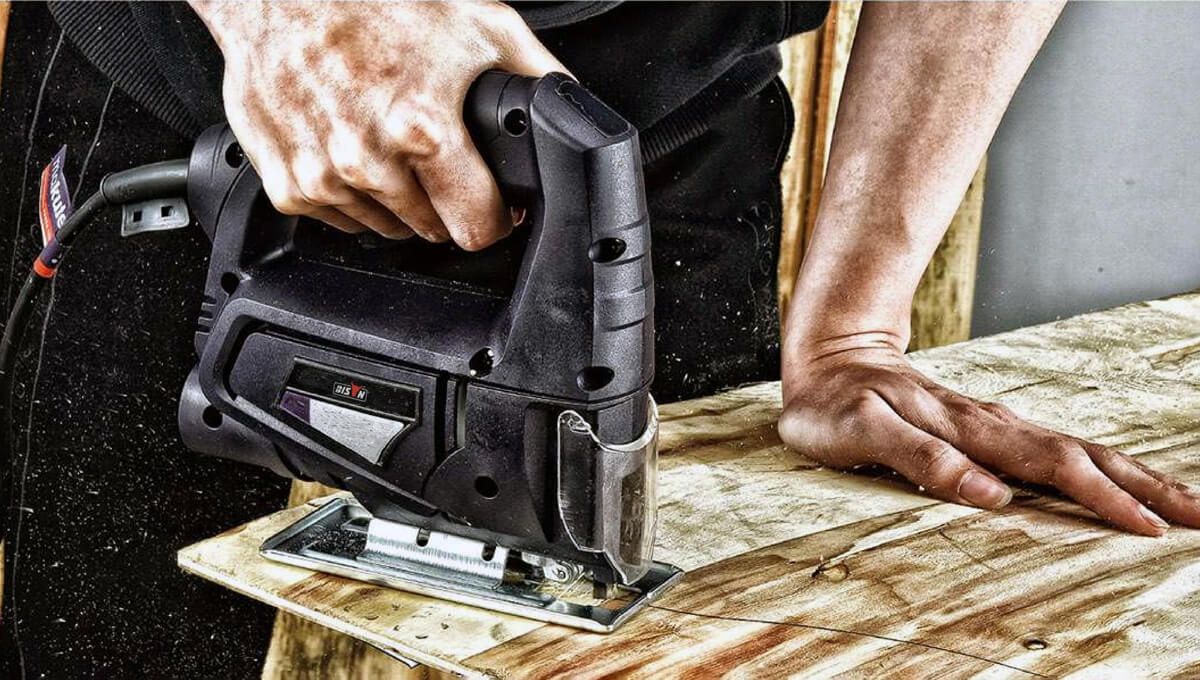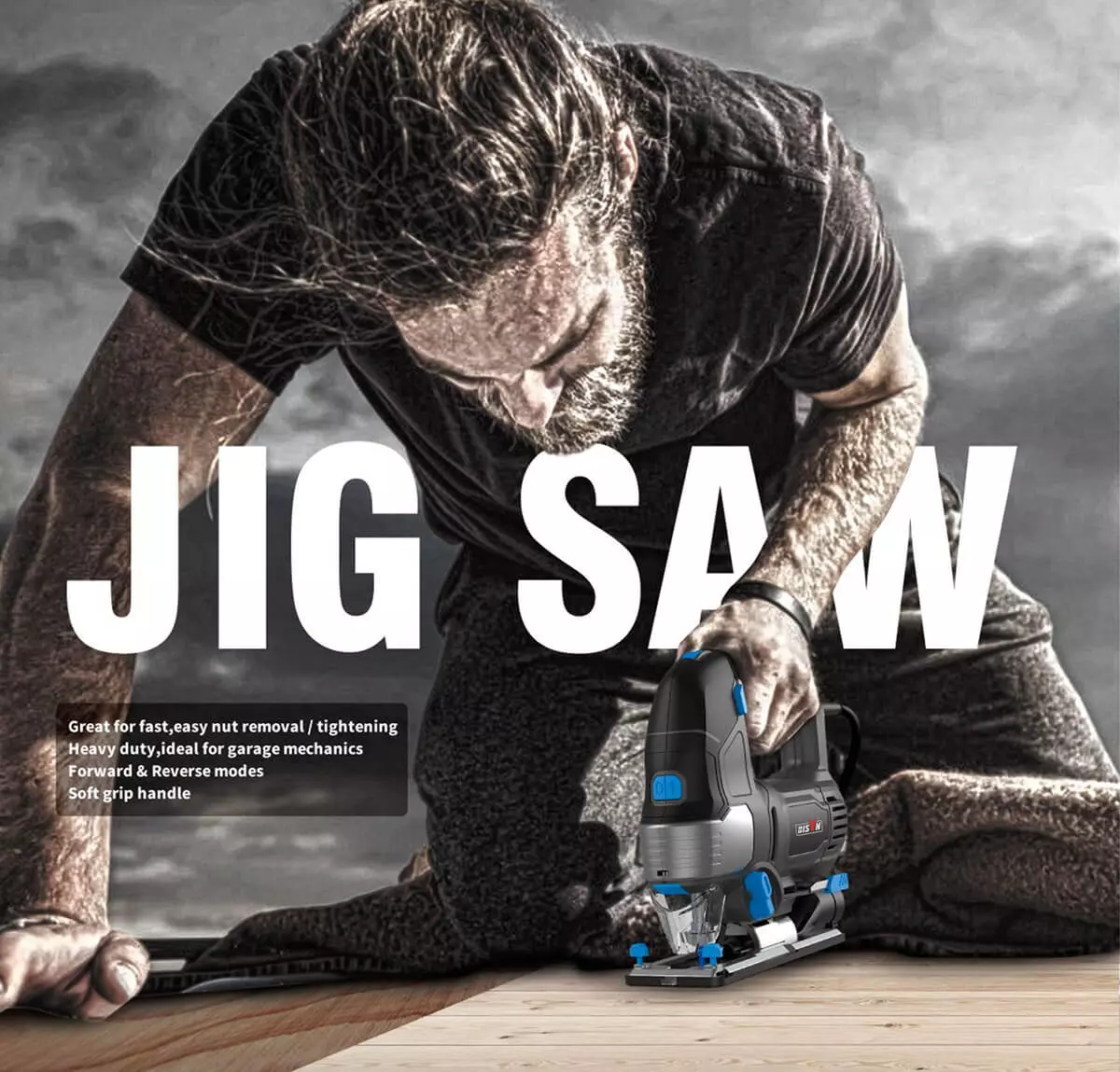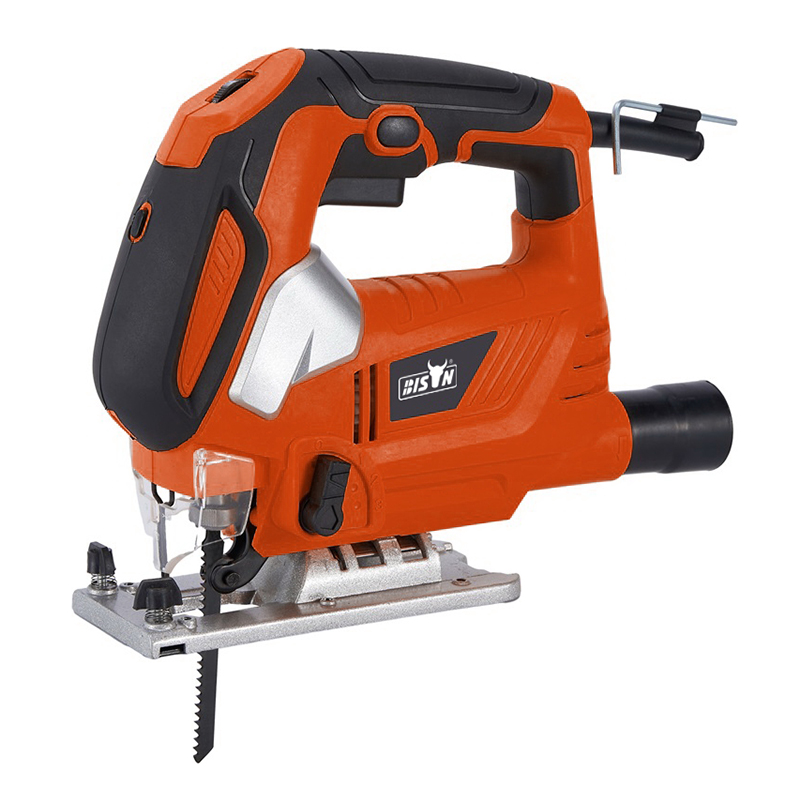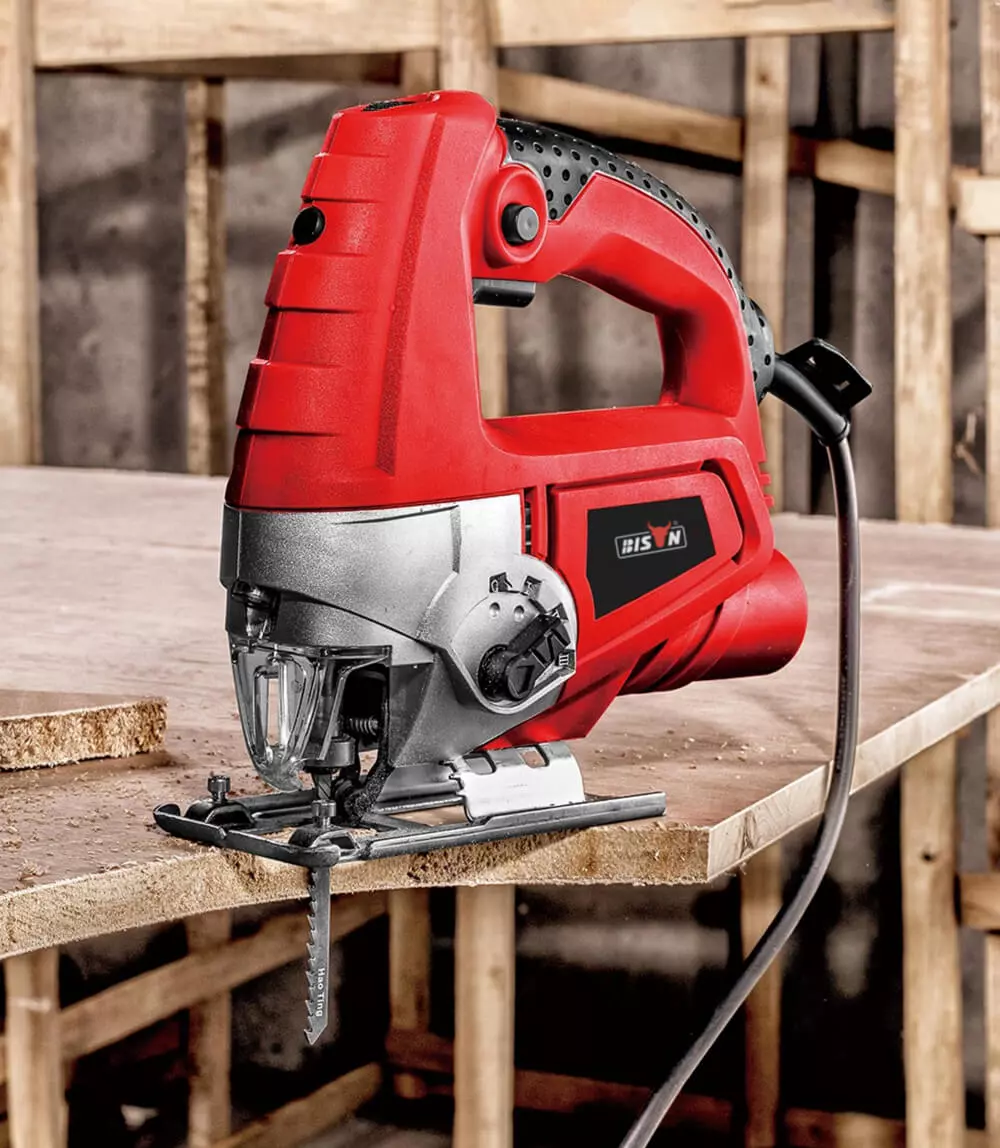A jigsaw is a versatile power tool that can be used to precisely cut a variety of materials, primarily wood, but also metal, plastic, and other substances. This handheld tool features a reciprocating blade that moves quickly up and down, making both straight and curved cuts with extreme precision. Its compact size and ease of operation make it an indispensable tool for professionals and DIY enthusiasts alike.
At BISON, we offer high-quality jigsaws that combine strength, versatility, and durability. Let us help you find the perfect jigsaw for your needs today.
Types of jig saws
When choosing a jig saw, it is essential to understand the different types available and their respective pros and cons. Let’s explore the main categories:
Corded jig saws
A corded jig saw is powered by connecting directly to an electrical outlet and offers greater power and continuous operation without having to worry about battery life. It is more powerful and affordable than a cordless model, plus it is lighter in weight due to the lack of a battery.
Cordless jig saws
A cordless jig saw is powered by a rechargeable battery, offering greater portability and convenience, especially for remote job sites where there is no power source. There are no cords to restrict movement or create trip hazards while working. In addition, the growing cordless tool ecosystem now allows for shared batteries, which increases runtime.
Key components of a jig saw
Motor
The motor is the heart of a jig saw, powering the blade's reciprocating motion. Many modern jig saws come with variable speed motors, allowing the user to adjust the cutting speed for different materials and applications.
Blade
The blade is arguably the most critical component of a jig saw, as it directly affects cutting performance and versatility. Be sure to select the right blade for the application.
Types of jig saw blades
Wood cutting blades: These have larger teeth designed for quick, rough cuts through a variety of woods.
Metal cutting blades: These have finer teeth designed for clean cuts through sheet metal and pipes.
Roll cutting blades: Narrow blades used for making intricate, curved cuts in wood.
Reverse-tooth blades: Teeth face upward, which reduces chipping of laminate materials.
Flush-cut blades: Allows the cut to be flush with the surface, ideal for trimming protruding nails or dowels.
Blade materials
High carbon steel (HCS) is best for cutting softwoods and plastics, it is relatively inexpensive but wears quickly
Bi-metal, such as a combination of high-speed steel teeth with a flexible high-carbon steel body. This type of blade is good for cutting metals and is generally more durable than HCS blades.
Carbide tips are characterized by being extremely hard and durable, best for cutting abrasive materials such as fiberglass, tile, and hardened steel
Tooth design and how it affects cutting
Teeth per inch (TPI): Higher TPIs produce smoother cuts but slower cuts. Lower TPIs produce faster, rougher cuts.
Rake angle: The angle of the tooth face. Positive rake angles cut more aggressively, while negative rake angles are better for harder materials.
Jigsaw base plate
The base, also called the shoe, is the flat plate on the bottom of the jigsaw, usually made of steel, aluminum, or durable plastic. The base plate needs to be sturdy and able to withstand a lot of pressure when you press it against the workbench. The surface of the base plate should be scratch-free and smooth. If the base plate has a non-slip feature, it will enhance the non-slip feature when cutting delicate and laminated materials. Many models come with an adjustable base for angled cutting (usually up to 45 degrees)
Handle type
There are two main handle designs for jigsaws: barrel handles and top handles. Each style offers unique advantages for different users and applications.
The barrel handle offers a lower center of gravity, greater stability, and control, and is ideal for precision work and intricate cuts.
The top handle is easier to maneuver, ideal for overhead or vertical cuts, and more comfortable when used for long periods of time.

How to choose jig saws: key factors to consider
Sourcing the best jig saw is often more complicated than it seems, and you should buy an efficient jig saw that costs the least. Before purchasing a jig saw, there are some factors to consider ensuring it will meet all your needs.
Power: corded vs. cordless
Consider your project needs and work environment. If you are selling to entry-level woodworkers or customers trying DIY projects, a cordless jig saw will be a great addition to your power tool inventory. If you are selling to professionals, you are better off choosing a corded electric jig saw as these products have higher SPM and amp ratings.
Power
Power is the main criteria for choosing a power tool. The power rating (measured in watts) determines the jig saw's ability to cut different materials. Higher power ratings (700 watts and above) are suitable for professional use and can handle thicker and denser materials. Lower power ratings (350-700 watts) are usually sufficient for home and DIY projects. You can also find corded jig saws rated in amps and cordless models rated in volts.
Stroke length
Stroke length refers to the distance the blade moves up and down in a single cycle. Longer stroke lengths (usually 3/4" to 1") allow for faster cuts, especially when cutting thicker materials. Shorter stroke lengths provide better control and allow for smoother cuts when cutting thinner materials. Some models offer adjustable stroke lengths for versatility
Stroke rate
The stroke rate, or the number of strokes per minute, affects the speed and type of material a jig saw can cut. It is measured in strokes per minute (SPM) and typically ranges from 500 to 3,500. Higher stroke rates are good for softer materials like wood or for making curved cuts, while lower stroke rates are better for cutting materials like metals and ceramics.
Look for a model with variable speed control, typically, high-performance jig saws have a speed dial with 7 settings. You can change the cutting speed of a variable speed jig saw depending on the material and level of precision you need. This flexibility allows for better control and cleaner cuts, especially when working with different materials.
Ergonomics and comfort
You need to consider the weight of the tool, evaluate the grip design (barrel grip vs. top handle) and consider the location and ease of use of controls (e.g., speed adjustment, power switch). Whenever possible, look for models with vibration reduction technology for increased comfort and control.
Price
Jig saws range from affordable models (around $50) to professional-grade tools (over $300). Higher-priced models generally offer better durability, more features, and better performance. BISON is a Chinese manufacturer of jig saws that offers customization services, so you can freely choose the features you need to achieve the best balance of price and performance.
Oscillating stroke capability
For vertical sawing motion, the rotation of the motor is converted into simple reciprocating motion by a speed reducer. This is a traditional feature of all jig saws.
Some jig saws are more complex and have an additional swing stroke. The oscillating action causes the blade to move slightly forward on the upstroke, which increases cutting speed. Such jig saws usually offer multiple settings (such as 0-3 or 0-4) to adjust the cutting force. Higher oscillation settings are better for faster, rougher cuts through rough sections of wood, plywood, and particleboard. Lower or no oscillation is better for metal cutting or achieving smooth and very accurate cuts.
Additional features
Dust management: Many jigsaws come with a built-in dust blower. It blows away sawdust while a small nozzle sprays a constant stream of air onto the workpiece to keep your cut line clear. Some models offer a dust collection port that can be connected to a vacuum system. That way, your vacuum can suck up all the unwanted debris while you're busy cutting continuously.
LED lights illuminate the cutting area for increased visibility. Laser guides project a line onto the workpiece to help users cut without straying off track. This is especially useful in low-light conditions or for precision work
Tool-free blade changing systems allow for quick and easy blade changes without the need for additional tools, which saves time and increases efficiency, especially when switching between different materials
Bevel cutting capability: First, to be clear, jigsaws are not designed for bevel cutting, but they do have some advantages worth considering. Manufacturers often provide preset stops at common angles (e.g. 15°, 30°, 45°) to allow the base plate to be tilted for bevel cuts. Look for models with an easy-to-use bevel adjustment mechanism.

For jig saw dealers: partner with a leading manufacturer
As China's premier jig saw manufacturer, BISON invites you to join our network of dealers and distributors. Offer your customers our jig saw models known for quality, innovation, and reliability.
Why partner with us?
Industry leading quality: Our jig saws are engineered to the highest standards of performance and durability.
Comprehensive warranty: Our robust warranty program gives your customers peace of mind.
Competitive pricing: Maximize profits with our attractive dealer pricing structure.
Contact our dealer relations team today to discuss partnership opportunities!






